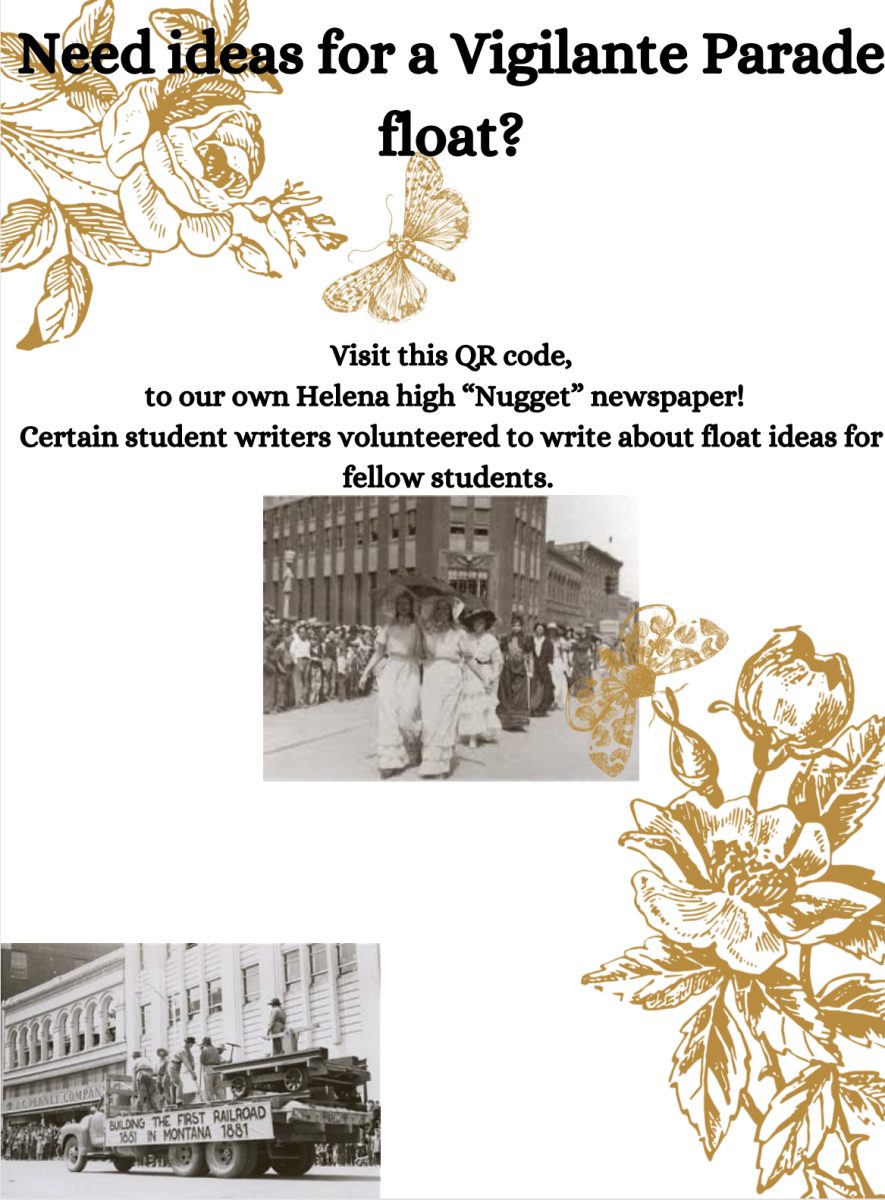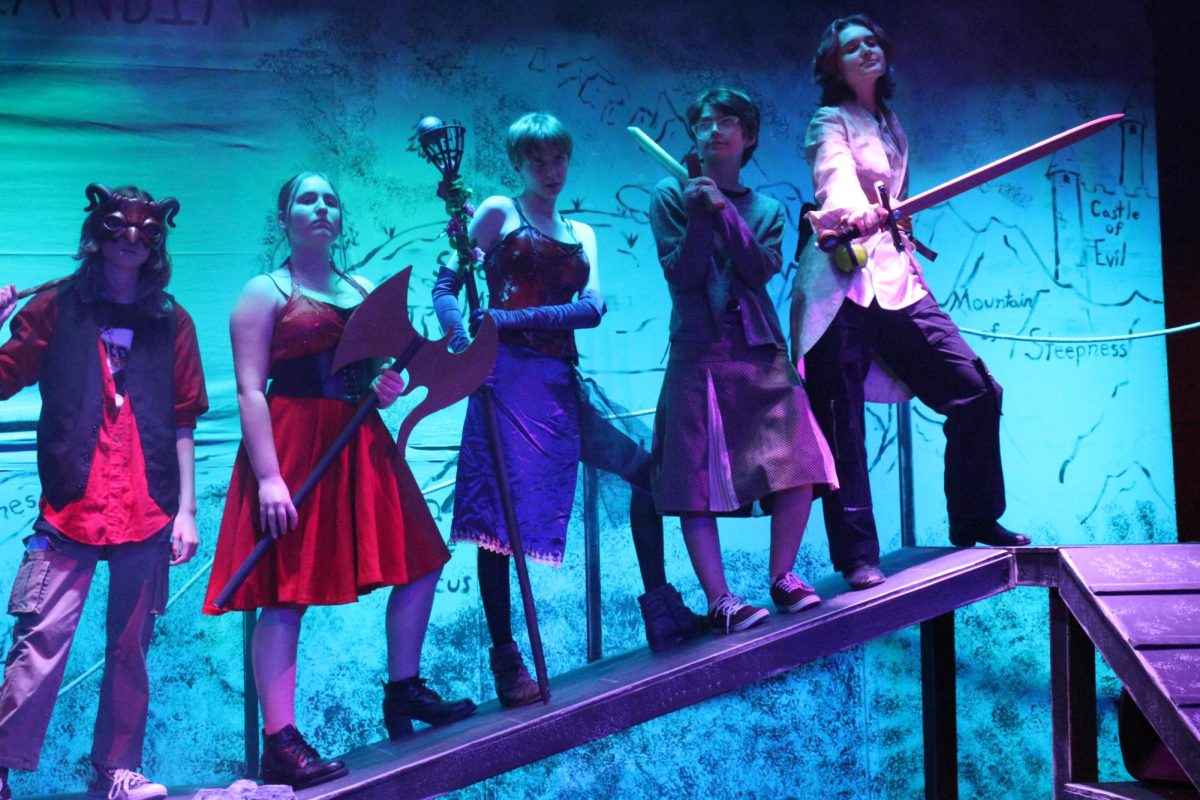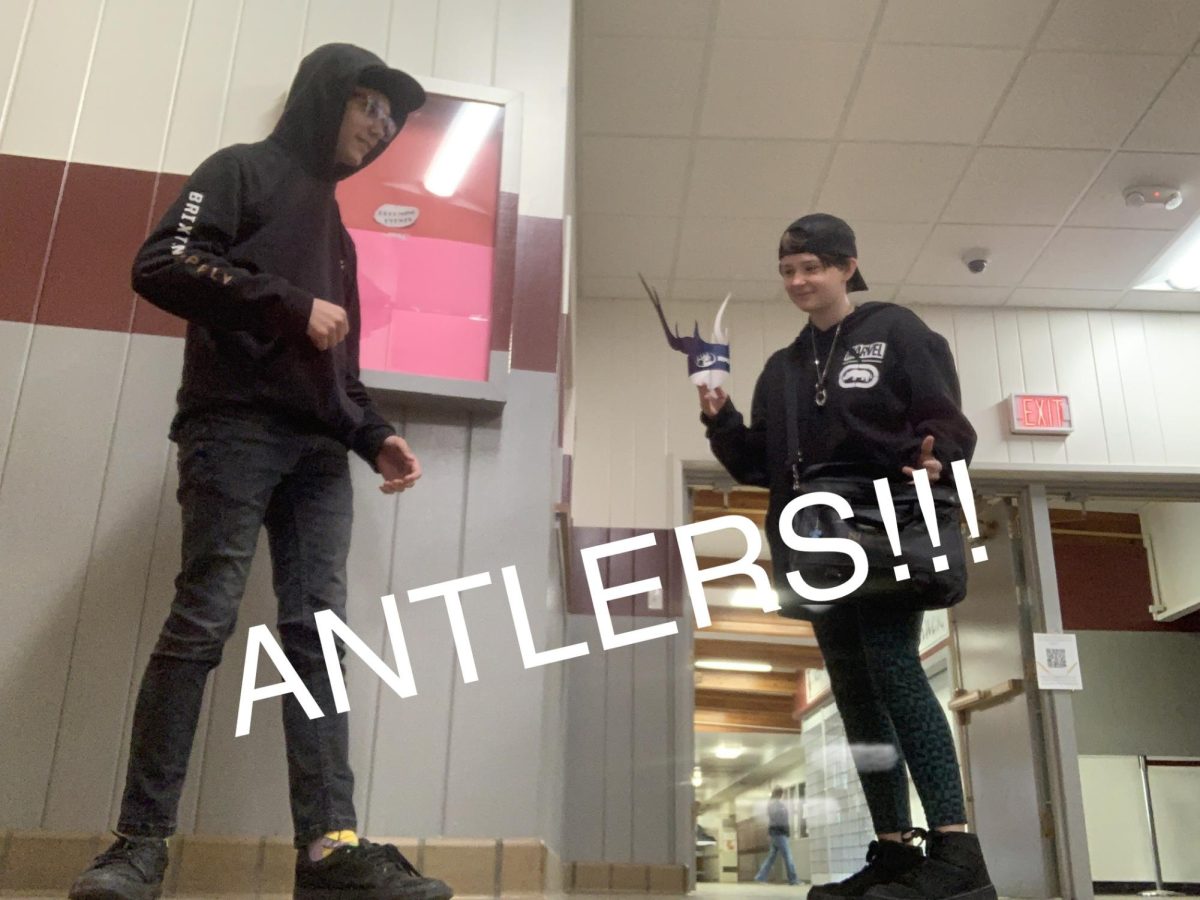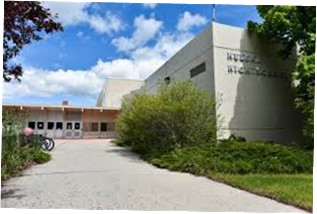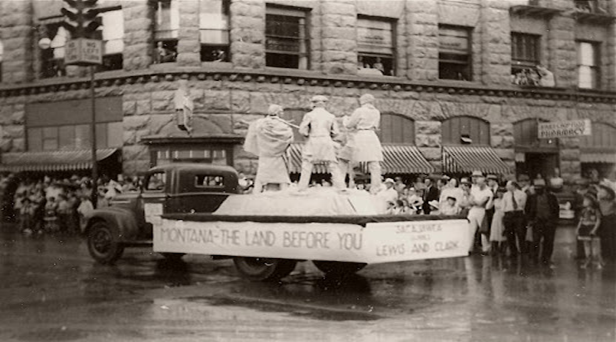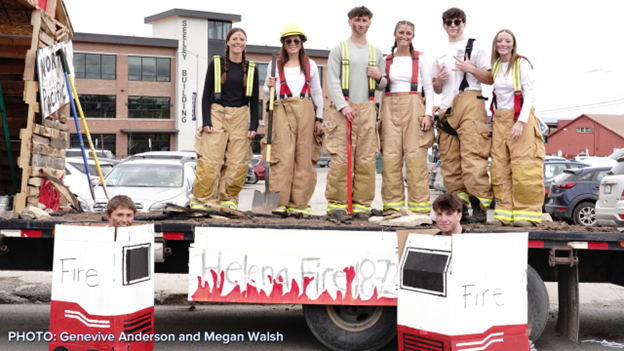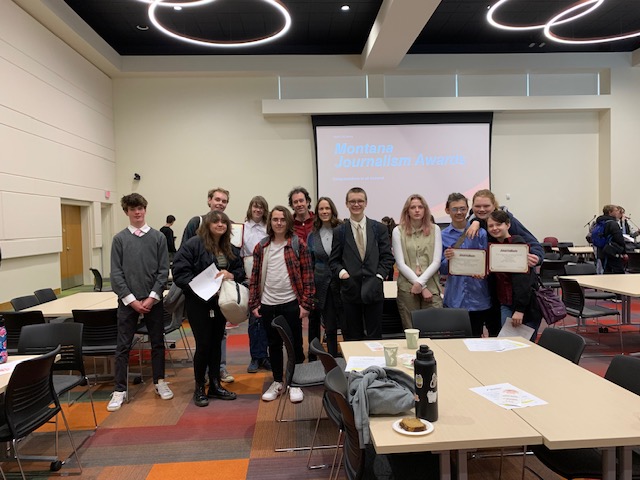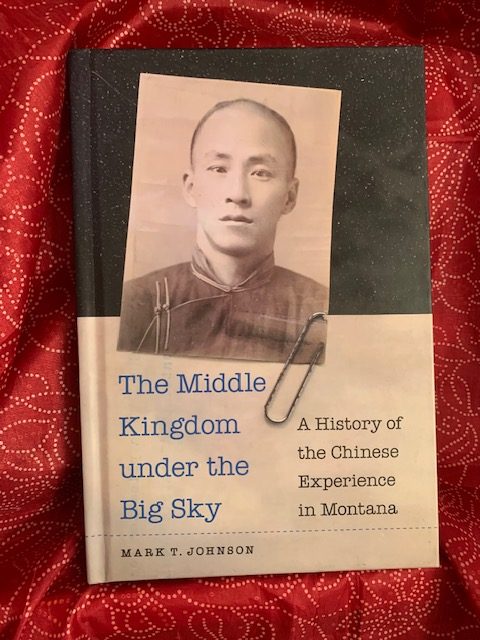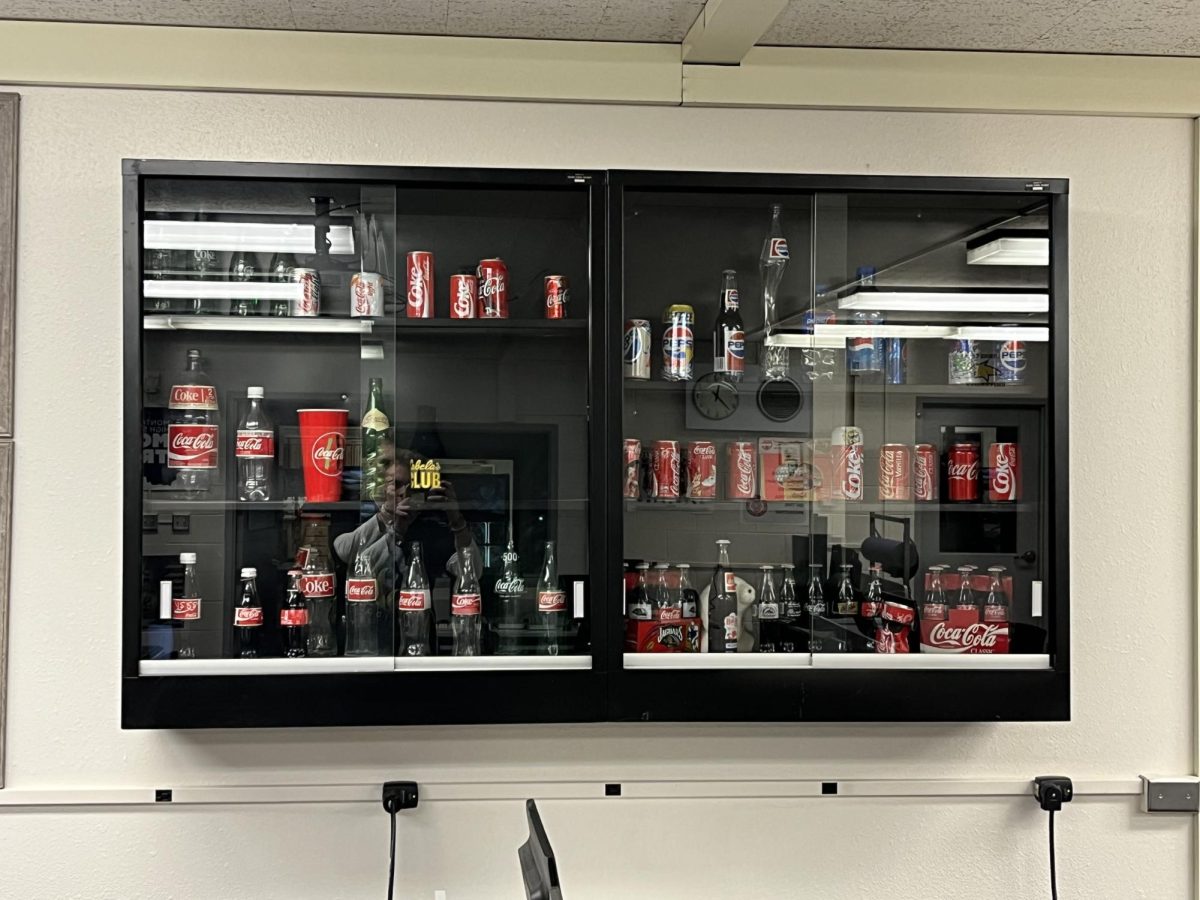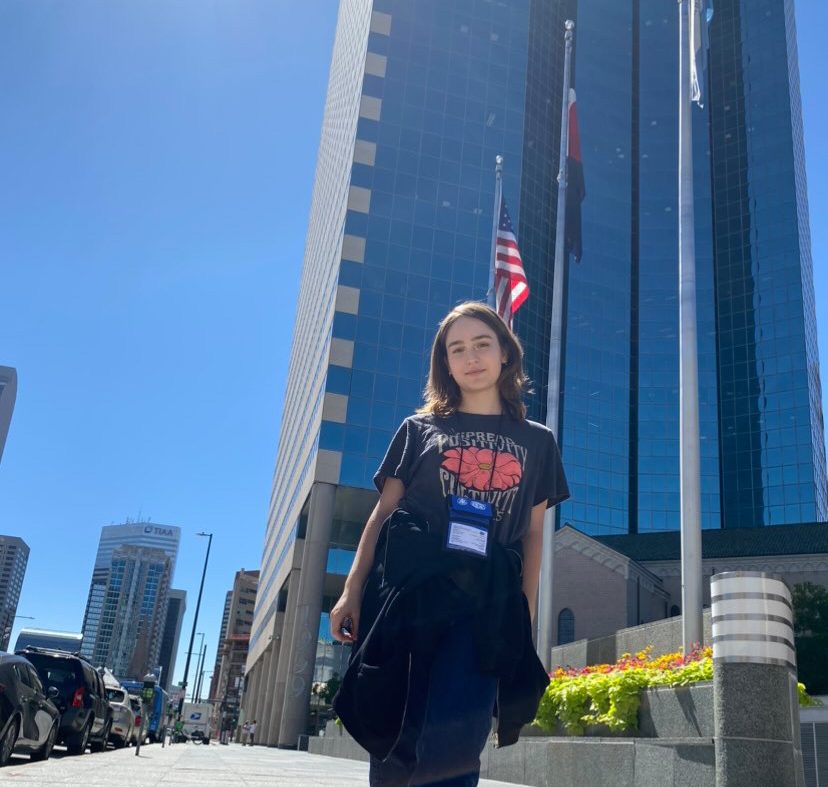On Friday May 3rd, Helena’s historic Vigilante Parade will once again travel its downtown route–this year, for its 100th anniversary.
For decades, Helena families and surrounding communities have flocked to Helena to celebrate the parade, but not many are aware of its origins.
As the story goes, Helena High once held a tradition known as “The Senior-Junior Fight” during the start of the 1900s. The online source Helena As She Was states that the object of the game was “for the juniors to take down and desecrate a senior-class flag, which seniors would run up a flagpole located between the High School and adjacent Central School.”
The fighting between the grades became so violent and dangerous that all elements of the event were banned from school grounds, which in turn spread conflict throughout the town and escalated violence and property damage.
To organize an alternative competition for the grades, students and administrators created a plan for a city-wide parade: “A grand pageant of historical floats, involving almost every student in a creative competition, and having at its heart the theme of the tough pioneer spirit” as stated by the same website.
Float registration for the 2024 parade began on Thursday, April 4, and will continue until Friday, April 19. Students may pick up materials and registration from Mrs. Lindgren’s room (205).
Below are some float ideas that haven’t been done at all or haven’t been done often. The judges like originality! To see photos of floats from years past, visit the HHS library and check out the displayed Vigilante Parade albums.
A big thanks to Montana Historical Society historians Martha Kohl and Aaron Rau for their assistance in providing ideas, including the bullet-point lists.
(Note: If the idea you select isn’t listed on the yellow “Vigilante Parade Entry Regulations” handout, be sure to ask Mr. Hussey or Mr. Schlepp at HHS for approval.)
NUGGETS of HISTORY
Float category: American Indian
- Helen Piotopowaka Clarke (1848-1923) was the first woman elected to public office in Montana. She was of partial Blackfeet descent.
- The history of the Helena Valley as an area regularly traveled as a crossroads by some of the major tribes in Montana: the Blackfeet, the Salish, the Crow, and the Bannock.
- “The great Salish road to the buffalo,” which passed through what is now Lincoln, MT, see link: Helena-Lewis and Clark National Forest – Resource Management (usda.gov)
Float category: Historic Helena
The Temple Emanu-el Synagogue by Gabe King
Completed in 1891 at 515 North Ewing St., the Temple Emanu-el served as a place of worship for the once-thriving Jewish community that first settled in Helena during the gold rush up until its decline in the 1930s. The temple’s construction plans were laid by Montana Governor Joseph K. Toole. But come the turn of the 20th century, the synagogue fell on economic hardships, and the population of Jews in Helena during the 1930s was just too small to operate the building. The synagogue exchanged hands from the state of Montana as an office space to the Montana Historical Society storage space from 1976 to 1980. In 20xx, 89 years later after its construction, it has now been taken back by a group known as the Montana Jewish Project. The synagogue stands as a symbol for the Jewish communities all over the state of Montana and a callback to Helena’s deeper connection to Judaism throughout the state.
https://www.montanajewishproject.com/
https://en.wikipedia.org/wiki/Temple_Emanu-El_(Helena,_Montana)
The YWCA by Gabe King
Since its founding in London, England, in 1855, the Young Woman’s Christian Association came to the United States in 1858 in New York and Boston. The Y’s of Helena were a special group because they comprised of both Catholics and Jews. Starting in 1911, the Y’s established themselves here in Helena to help younger women and girls find jobs in the workplace such as teachers or tailors while also helping those who could not afford or find housing, medical care, and other such common needs. The original headquarters still to this day are at 501 North Park Avenue, where it stands today as a reminder of how proud Montana and Helena is of her daughters and to how these women groups help build up our old town from the ground up.
http://www.helenahistory.org/ywca.htm
Other Historic Helena ideas:
- “Auto Row” in the Empson Buildings: transportation_automobile (helenahistory.org)
- St. John’s Hospital (1884-1973): Saint John’s Hospital (helenahistory.org)
- Capital Music Hall: Capital Music Hall (helenahistory.org)
- Green Meadow Ranch/Farm: Green Meadow Ranch (helenahistory.org)
- Central School (before demolition): Central School (helenahistory.org)
Float category: Pioneer Life
Reeder’s Alley by Gabe King
Almost 10 years after the American Civil War, the 1870s saw one of the first real settlements appear in what would be known as our capitol city of Helena, Montana. Originally known as Cutler Street, the area was a settlement that appeared as a result of the gold findings of 1864 by a group known as the Four Georgians: Reeder’s Alley, named after Pennsylvania stonemason Louis Reeder after his investment in the area. He wanted to provide fire-proof housing for the local miners. This unique brick walkway and collection of brick buildings is one of the oldest areas in Helena and Montana.
Reeder’s Alley has stood the test of time, weather, and other elements of nature. It holds the pioneer’s lifestyle, the earliest Chinese influence, and represents how men and women came here to seek their fortune. Its buildings hold the original Pioneer’s Cabin that was built in 1864, with its original personal belongings and artworks. Today it is protected by the Montana Heritage Commission for all to walk the very same streets of that settlers walked before us.
https://www.reedersalley.com/History/index
The Bozeman Trail by D.J. Knickerbocker
In 1863 miner and guide John Bozeman turned an ancient native American travel corridor into an offshoot of the Oregon Trail. The point of the new trail was for a shortcut to the goldfields. There were several advantages to the trail, such as a better supply of water and a more direct route to the goldfields, compared to previous trails. However, the pioneers were under constant threat of attack from various Native American tribes who had previously used the trail for hunting. The taking of the trail by the settlers caused a two-year war called “Red Cloud’s War.” The Fetterman Fight saw an army detachment of 79 soldiers who were all killed by native warriors who were fighting to protect their land. Today, Interstate 90 follows much of the old Bozeman Trail.
https://www.wyohistory.org/encyclopedia/brief-history-bozeman-trail
Float category: Helena Business
Marlow Theater by Will Eaton
The once beloved and longtime Marlow Theater is all but forgotten from recent Helena memory. Cited as Helena’s “Majestic Old Palace” by the Helena Independent Record in 1972, the Marlow Theater was built in response to the closing of the Helena Theater in 1914. Without a performing venue for touring road shows and acts, concerned Helena citizens including eventual investor Thomas A. Marlow organized a fund drive.
After a few years of construction, the theater was completed and opened to the public on April 3, 1918, located on Edwards St., just west of Main. The building was renowned for its grand and impressive architecture. Covering the theater’s demolition in 1972, Charles S. Johnson wrote, “We were awestruck by the plush splendor of the Marlow. The high arches, gargoyles, bright carpeting, stripped walls, soft seats and velvet curtains . . . It was the place where westside kids mingled with eastsiders and public school kids met those attending parochial schools” Johnson would go on to say.
The theater had a long history in the city with “talkies” being introduced in 1929, and John F. Kennedy visiting the theater in 1960 for the Montana State Democratic Party Convention in Helena. But the theater’s curtains would fall one last time in 1972 when it was demolished to enlarge the street for urban renewal.
http://helenahistory.org/marlow_theatre.htm
http://helenahistory.org/Marlow_Theatre_Last_Days_1972.pdf
Broadwater Hotel and Natatorium by Will Eaton
Helena’s famed Broadwater Hotel and Natatorium continues to be mythologized today. In 1865, the ground’s hot springs were first developed as a bathhouse for miners working in Last Chance Gulch. In 1889, Charles Broadwater built the regal Broadwater Hotel and Natatorium, featuring the world’s largest indoor plunge. The resort was decorated in an extravagant and luxurious Victorian style, consisting of “elaborate woodwork, stained glass windows, cut crystal and oriental carpets,” according to helenahistory.org.
The hotel operation and success eventually slowed and downsized, beginning to focus primarily on local residents. The 1935 Helena earthquake would create an insurmountable problem, collapsing the pool’s thermal vent, eventually causing the natatorium’s closed. The hotel would close forever in 1941. Shortly after, miner Norman Rogers acquired the property, who announced plans to remodel and open the hotel and plunge. Rogers would end up using the hotel and grounds as a storage facility and dumping ground for scrap and would never renovate the resort. Most of the hotel’s structure was demolished in 1976 and 1989. All but three of the original buildings were demolished. The stone stable, the billiards room, and the carriage house are all that’s left.
–http://www.helenahistory.org/Broadwater_the_hotel.htm
–http://www.helenahistory.org/Broadwater_natatorium.htm
Montana Club by Will Eaton
Helena’s Montana Club was a staple in the Helena community for nearly 140 years, only closing this past March. Founded in 1885 “by fifty male attorneys, bankers, mining, livestock and timber magnates, politicians, transportation titans, wholesalers and self-described capitalists, the Montana Club was the longest-continuously open private club between Minneapolis and Seattle,” according to The Montana Club website. The club would continue to be an exclusive business until 2018 when it reorganized as a co-operative association and opened to the public. “From the majestic second floor dining room to the intimate wood-paneled Russell Room to the cozy Rathskeller and the Banquet Hall with panoramic views of downtown and Mount Helena” the Montana Club will continue to be remembered by Helena residents.
Other Helena Business float ideas:
- Rocky Mountain Telephone: Rocky_Mountain_Telephone (helenahistory.org)
- New Cash Market: New Cash Market (helenahistory.org)
- 1890 Montana Guard Arsenal & 1942 Montana Guard Armory: Arsenal and Armory (helenahistory.org)
- Power-Townsend hardware store
Float category: Famous People
War of the Copper Kings by Iain Maciver
Montana has never known such a fierce rivalry as the contest between Marcus Daly and William Clark for control of the capital city of Montana. Back in 1894 Daly and his Anaconda Company had an enormous foothold in the growing company town of Anaconda while William Clark and his far bougier Helena-based following dominated much of Butte and Helena. The election for where the capital would be was more a proxy war between Clark and Daly than anything else, and both parties dumped mind-boggling sums of money into the endeavor.
The two powerful Montanans “applied all their resources to persuade voters. They sponsored parades, speeches, and fireworks. They distributed free cigars, drinks, and $5 bills to win people’s loyalty. Clark handed out miniature men’s shirt collars made of copper to symbolize the stranglehold the Anaconda Mining Company would have on Montana if Anaconda won. Daly opened ‘Anaconda for Capital’ clubs across the state and turned them into social centers. to gain more influence, the two men also bought newspapers—or paid editors to support their cause,” according to Montana PBS Learning Media.
Ultimately Clark succeeded which can possibly be accredited to his control over public rhetoric thanks to his newspaper, The Butte Miner, the most popular issue among the populous.
The Road to Helena Becoming Montana’s Capital
The founder of Scientology: L. Ron Hubbard by Iain Maciver
Helena history is incomplete without mention of our very own cult and its leader, Mr. L. Ron Hubbard. Hubbard’s whole family, including grandparents, resided in a large home near Broadway Street during their time in Helena. Hubbard had a brief stint as a student here at Helena High but was dropped from enrollment due to failing grades, a since-forgotten practice in public education. Upon dropping out of George Washington University, Hubbard unlisted in the United States Navy where Hubbard would be honorably discharged because he was deemed “mentally unfit for service.”
Scientology is a religion about one’s self. Historically, scientology has been popular with the hyperinflated egos of Hollywood because of its focus on relying on one’s self rather than external forces. Many discredit the merits of Scientology as Hubbard was known for his fictional works and even holds the record for most fictitious novels by a single person. (Via What Is Scientology?) Notable members of the church include Tom Cruise, Juliette Lewis, and Elizabeth Moss.
Whether or not you buy into their superhuman spiritual ascent thing or not, no one can deny the interesting history of Scientology in Helena.
https://en.wikipedia.org/wiki/L._Ron_Hubbard
Thomas Cruse, the luckiest and unluckiest miner by Iain Maciver
Most people think of enduring hardship, finding gold, and traversing the picturesque high plains deserts when the Wild West is brought up, and the story of Thomas Cruse encompasses all three. Born into a poor family in Ireland in 1836, Cruse could never read or write but would eventually find himself in a position of enormous power amongst some of the most important people in the early 20th century. After striking it rich finding, working, and selling the Drumlummon Mine in Marysville, Cruse went on to spend like a king. The pinnacle of Cruses’s expenditures was a $350,000 ($10,930,000 in today’s money) donation to The Catholic Diocese to aid in the construction of the Saint Helena cathedral here in Helena. Almost poetically, Cruse died just days before the unveiling of the St. Helena cathedral. His funeral was the first assembly at the new cathedral, bringing an end to one of Helena’s most generous philanthropists.
Helena Photographer L. Jorud by D.J. Knickerbocker
In Helena in the 1930s-1950s there was a photographer named Leslie H. Jorud. He is one of, if not the most, well-known photographers in Helena’s history. He is well-known for taking early photographs of Helena, including videos and photos of the early Vigilante Day parades. He also recorded a total solar eclipse like the one on Monday April 8, 2024. The Montana Historical Society explains Jorud’s importance on its website: “Photographically documenting one community [Helena] for more than fifty years is a remarkable feat. Equally remarkable is the fact that Jorud methodically maintained his negative collection—numbering more than 70,000—for five decades!”
https://mhs.mt.gov/Membership/Docs/newsletter/2020StarWinter.pdf
More Famous People ideas
- Charles Arthur Broadwater: real estate, railroad, and banking tycoon
- Sydney Edgerton: 1st Territorial Governor of Montana
- Samuel V. Stewart: 6th governor of Montana
- Joseph K. Toole: 1st and 4th Montana State Governor
- Helen Piotopowaka Clarke (1848-1923)
- Margaret Craven (1901-1980), author
- Vida Ravenscroft Sutton (1878-1956), playwright and radio professional
- Jean Baucus (1917-2011), historian and rancher
- George Harper, Methodist pastor, member of Constitutional Convention, and long-time strong supporter of HHS (the HHS gym floor has been named the “Harper” floor)
Float category: Mining and Transportation
Helena’s Streetcars by Jack Royal
Have you seen the yellow streetcar in front of the Windbag Saloon in the walking mall? Downtown Helena shows off one of its original streetcars, donated by Mrs. And Mr. Charles Bovey 50 years ago. This donation and display is the streetcar’s second life. Its first, of course, was when it actually operated, taking Helena passengers all over town. The streetcars were essentially electric buses on trolley lines, but in ye olden times. They were taken off the road when cars were introduced, leading to the collapse of pedestrian cities. The original Helena streetcar ran through the Kessler Brewery and Central Park. It ran between present-day Knight and Choteau streets.
https://www.hmdb.org/m.asp?m=186608
The Speculator Mine Disaster by Jack Royal
On June 17, 1917, the Granite Mountain/Speculator Mine disaster struck in the tunnels of this Butte copper mine. The catalyst was a foreman’s carbide lamp, setting the cable ablaze, and killing the miners below. Most of the 168 people who died were asphyxiated. Many wrote notes, hoping for salvation or to pass on a message to a loved one, as most did not die immediately, and some lasted two days in the ensuing smoke. The incident was a turning point in the volatile relationship between the owners and workers of the mines. A memorial is on the site, in memory of those who perished.
https://en.wikipedia.org/wiki/Speculator_Mine_disaster
Sluice Mining in Montana by Jack Royal
Sluice mining in Montana goes all the way back to the Gold Rush. A sluice separates the sand and gravel from the gold. This era of mining caused riverbeds to be flooded with rocks, and other forms of waste from mining. Many mining camps or towns sprang up to capitalize, but as mining for gold died out, the towns died out, and became ghost towns.
https://www.britannica.com/technology/sluicing
- “Good Roads Day” work on York Road outside Helena in 1916 following the meeting of the Helena Automobile Club
- The Steamboat Helena: transportation_missouri_river (helenahistory.org)


